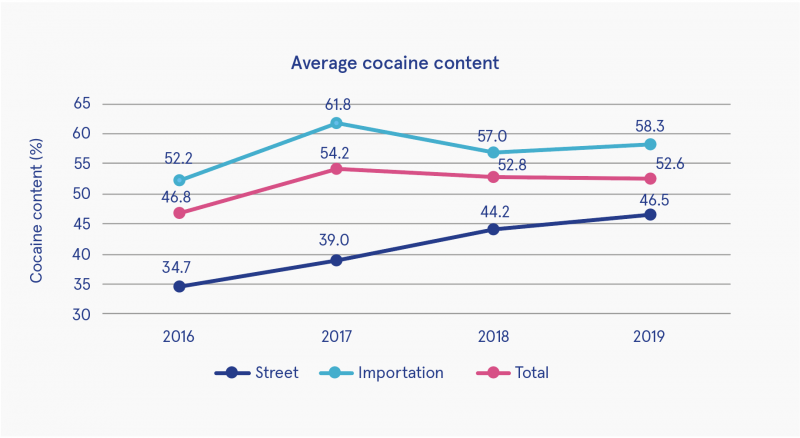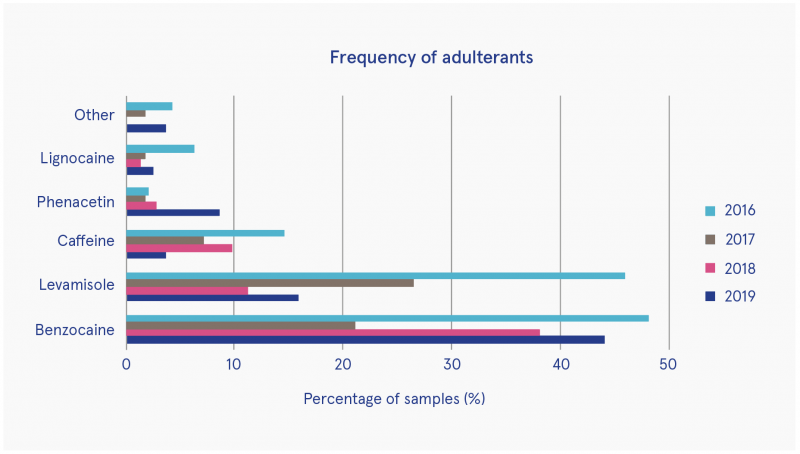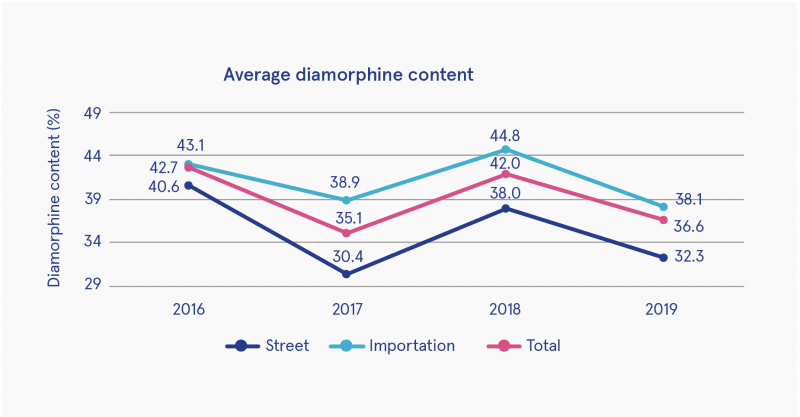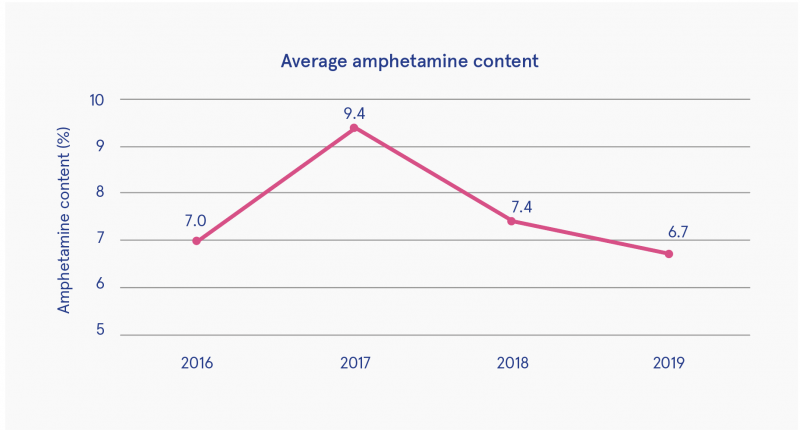Hanniffy, Sarah and Kavanagh, Yvonne (2021) Irish drug quantification trends for cocaine, diamorphine, and amphetamine 2016–2019. Drugnet Ireland, Issue 77, Spring 2021, pp. 43-46.
| Preview | Title | Contact |
|---|---|---|
|
PDF (Drugnet Ireland 77)
1MB |
Forensic Science Ireland (FSI) is an associated office of the Department of Justice delivering comprehensive scientific analysis, independent expert opinion, advice, and training to support the Irish criminal justice system. The analysis of substances that are suspected to contravene the Misuse of Drugs legislation comprises the majority of submitted cases to FSI. Analysis of these cases is carried out by the Chemical Analysis Department in FSI and cases range in both content and complexity.
The Chemical Analysis Department contributes to the European Union (EU) Early Warning System for the reporting of emerging drug trends via the European Monitoring Centre for Drugs and Drug Addiction (EMCDDA), the drugs working group in the European Network of Forensic Science Institutes (ENFSI), and the Early Warning and Emerging Trends (EWET) group in Ireland. The majority of drugs cases brought to FSI are submitted by An Garda Síochána (AGS) and, in addition to the reporting of these cases, FSI provides intelligence data to AGS. These data support the understanding of the illicit drug market in Ireland and include quantification data for some of the most commonly seized materials.
Quantification data are produced for intelligence purposes for three substances: cocaine, diamorphine (heroin), and amphetamine. Data are presented below. These were the second, third, and tenth most commonly seized drugs, respectively, in 2019.1 The data also include the most commonly identified adulterants. An adulterant is defined as any extraneous substance found in addition to the analyte of interest. Two distinct levels of seizure are analysed for quantification of cocaine and diamorphine: street level and importation level. Street-level samples are defined as those submitted from seizures less than 30 g, primarily between 25 and 30 g, while importation-level samples are defined as those submitted from seizures primarily over 500 g. For amphetamine, all seizures over 25 g were quantified.
Cocaine
Cocaine was the most commonly seized stimulant in Ireland across the four-year period (2016–2019) examined and the second most commonly identified compound after cannabis in FSI in 2019.2–6 In 2019, 26% of all drugs cases analysed in FSI contained cocaine, which was equivalent to 222 kg of powder/substance.1 Figure 1 illustrates the annual average cocaine content during the time period examined. The content has remained broadly consistent over the four-year period, with an increase at street level noted. European data support the increase in cocaine content seen in Ireland over the time interval detailed in this report. An increase in trafficking routes, supply, seizures, and seizure volumes are noted in this time period, ultimately leading to an increase in cocaine content for users.2 The importation-level content is consistently higher than the average at street level.
In the three analytes examined as part of the quantification project, cocaine demonstrates the widest variety in adulterants. Figure 2 depicts the range of compounds detected as part of the submitted cocaine samples. With the exception of 2017, benzocaine is the most commonly detected adulterant across the time period, closely followed by levamisole. Some of the other adulterants not named in Figure 2 include creatine/creatinine and hydroxyzine.

Figure 1: The average cocaine content at street and importation level, 2016–2019

Figure 2: Comparison of the adulterants in submitted cocaine samples across street-level and importation-level seizures, 2016–2019
Diamorphine (heroin)
Diamorphine is a semi-synthetic product produced by the acetylation of morphine, which occurs as a natural product in opium. The drug is controlled in the Republic of Ireland. Diamorphine is the most commonly encountered opioid in Ireland and throughout the EU and was the third most commonly identified compound in FSI in 2019.2–6 In 2019, 15% of all drug cases analysed in FSI contained diamorphine, which was equivalent to 50 kg of powder/substance.1 Figure 3 shows the annual average diamorphine content over the four-year period. Some year-to-year variability is noted, with the importation-level average content higher than street-level. A stable supply of diamorphine from established trafficking routes is consistent with data from other European countries.2 The diversifying opioid market worldwide, specifically in North America, has largely evaded the EU, which is also the case in Ireland.
Caffeine and paracetamol are the most commonly detected adulterants in diamorphine seizures. Caffeine and paracetamol were found together in 49.5% of all samples analysed as part of the quantification project over the four-year period; this figure is higher at street level (64.1%) than at the importation level (42.5%). Other adulterants detected by the FSI method include clotrimazole and MDMA.
Amphetamine
Amphetamine is the second most commonly encountered phenethylamine in Ireland, after MDMA. It was the tenth most commonly identified compound in FSI in 2019.1 In 2019, 2.5% of all drugs cases analysed in FSI contained amphetamine, which was equivalent to 27 kg of powder/substance. Figure 4 illustrates the annual average amphetamine content over the four-year period. Average amphetamine content has remained broadly consistent over this time. EU regulations have largely focused on the control of precursor chemicals as the manufacture of amphetamines are generally local to the supply chain. A decrease from 2018 onwards after a peak in 2017 is potentially linked to the introduction of controls to precursor chemicals such as alpha-phenylacetoacetamide (APAA) and derivatives of benzyl methyl ketone (BMK); a similar decline was noted in 2013 after similar controls were introduced in Europe.2
Caffeine is by far the most consistently detected adulterant in amphetamine seizures. In terms of adulterants, 86.25% of samples submitted for analysis over the four-year period were found to contain at least one adulterant. In the case of adulterated samples, caffeine was always detected.

Figure 3: The average diamorphine content at street and importation level, 2016–2019

Figure 4: The average amphetamine content, 2016–2019
1 Forensic Science Ireland Case Data 2019 (unpublished).
2 European Monitoring Centre for Drugs and Drug Addiction (EMCDDA) (2019) European drug report 2019: trends and developments. Luxembourg: Publications Office of the European Union. https://www.drugsandalcohol.ie/30619/
3 An Garda Síochána (AGS) (2017) An Garda Síochána annual report 2016. Dublin: AGS.
https://www.drugsandalcohol.ie/27780/
4 An Garda Síochána (2018) An Garda Síochána annual report 2017. Dublin: AGS.
https://www.drugsandalcohol.ie/29532/
5 An Garda Síochána (2019) An Garda Síochána annual report 2018. Dublin: AGS.
https://www.drugsandalcohol.ie/32192/
6 An Garda Síochána (2020) An Garda Síochána annual report 2019. Dublin: AGS.
https://www.drugsandalcohol.ie/33478/
B Substances > CNS stimulants > Amphetamines
B Substances > Cocaine
B Substances > Opioids (opiates) > Heroin
E Concepts in biomedical areas > Pharmacology and toxicology
E Concepts in biomedical areas > Pharmacology and toxicology > Purity / adulterant
VA Geographic area > Europe > Ireland
Repository Staff Only: item control page